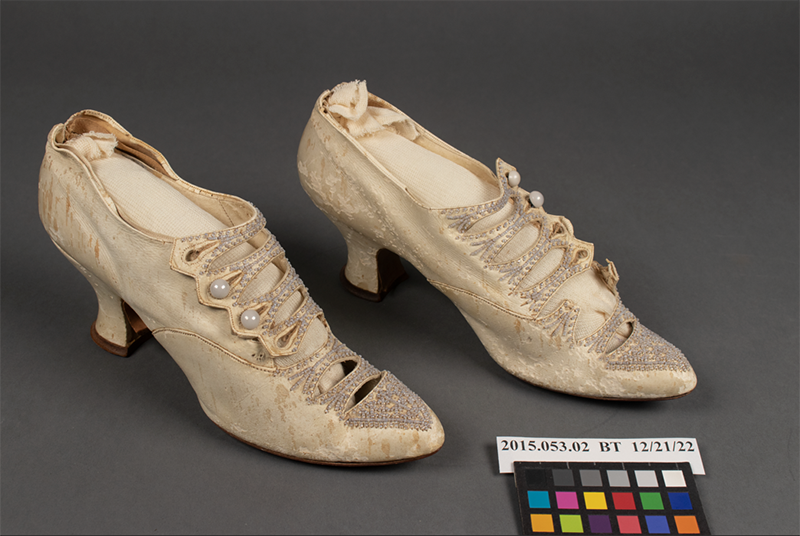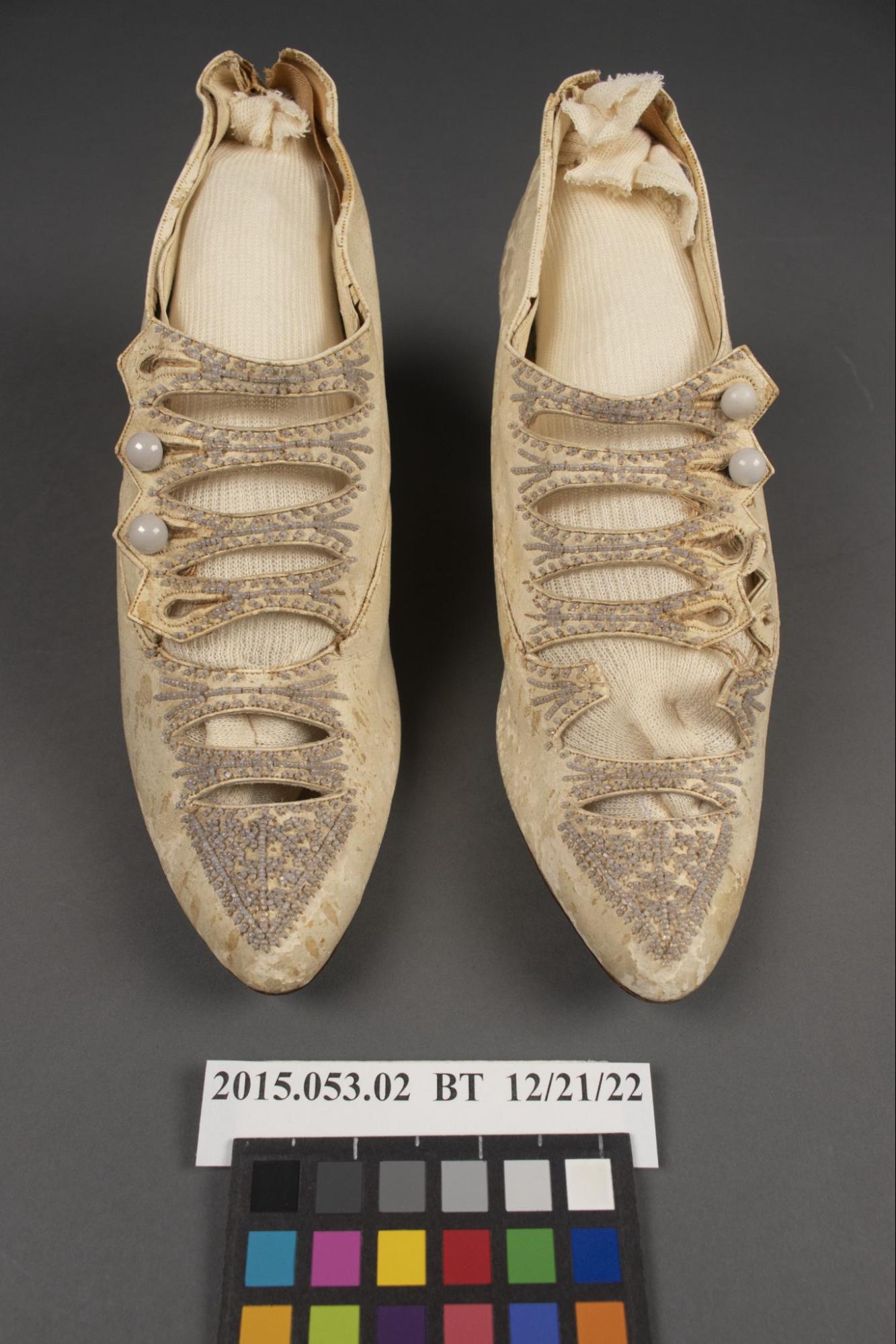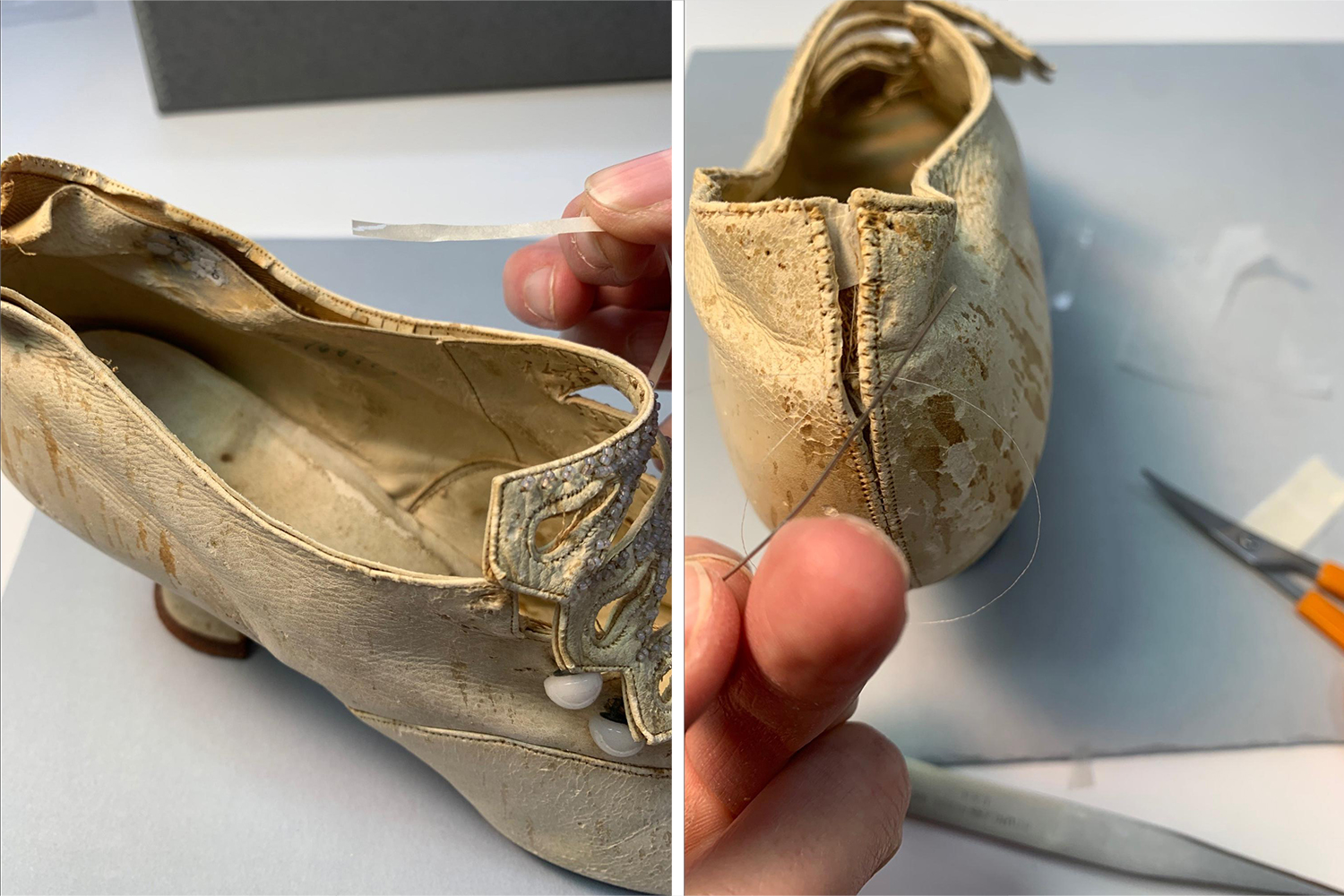A pair of late-19th-century wedding slippers recently came to the Gerald R. Ford Conservation Center for treatment. These shoes are part of the Frontier Army Museum’s collection and exhibit features consistent with Victorian-era footwear trends. During this era, women’s shoes typically had a delicate appearance with rounded heels and pointed toes. Boots were typical for daily wear, but pumps were also fashionable, particularly for formal occasions. Shoes with cutouts tended to be worn by more elite classes, as they had more embellishments. They allowed the wearer to show off the quality of their stockings.
Incidentally, Queen Victoria of England’s 1840 wedding is generally credited with inspiring the Western trend for brides to wear white dresses and accessories. Before this royal wedding (and throughout much of the 19th century in the United States), wedding dresses came in various colors. Often, a woman’s wedding dress would be used for multiple formal occasions throughout her life.

This 1893 wedding dress sold by the Frederick Loeser & Company department store reflects American trends toward the end of the 19th century. Image source: https://www.metmuseum.org/art/collection/search/159494.
The white kidskin, cutwork vamps, and beadwork details on the shoes from the Frontier Army Museum all indicate that they were made to be worn by a wealthy woman on a very special occasion.

This before-treatment image of the wedding slippers shows their sleek Victorian silhouette and the cutwork and beaded embellishments.
Records at the museum show that Susanne Bonaparte Palmer wore these shoes at her May 1880 wedding to Eben Swift. Swift was commander of the 5th Cavalry at the time, posted in several western states during the Indian Wars. Both Susanne and Eben were born in Texas. Their wedding took place in Washington, D.C. Susanne was from a high-ranking military family herself – her father, Colonel Innis Newton Palmer (2nd U.S. Cavalry), served for over 30 years, with involvement in the Mexican-American War, U.S. Civil War, and Indian Wars.
When these 140-year-old shoes arrived at the Ford Center, their materials had degraded significantly. Though they appeared relatively intact, they had become highly fragile over time. Much of the cotton stitching had failed, causing the uppers to loosen from the soles and the loss of some beadwork. Presumably, the cotton fibers’ breakdown was partly caused by prolonged contact with the acidic alum-tawed leather. One of the cutwork straps was broken, and some of the material had been lost. The shoes’ color was a light cream, but there were dark stains concentrated around the toes and heels of the shoes. The shoes also have areas where the surface of the leather has been skinned away to reveal a lighter white color. This damage was likely caused by protein-eating insects.

The compromised stitching, broken strap, and discoloration are visible in this before-treatment photograph.
After documentation, some initial tests were carried out to determine the tolerances of the materials. It was found that the leather was extremely fragile and very absorbent. As a result, the shoes could not be cleaned using solvents that might have reduced the staining. They could only be cleaned using dry techniques that removed some surface soiling. The beadwork was cleaned and stabilized so that handling would not cause additional material loss.
The failed cotton stitching was carefully replaced using fine thread silk. Areas, where the leather was coming apart, were reinforced using goldbeater’s skin, a strong and thin material made from cattle intestines. Goldbeater’s skin was also used to mend the broken strap on the left shoe. The detached buttons were stitched back on, and one replacement button was created and is detectable under close inspection.

Left: A strip of goldbeater’s skin with a reversible adhesive is used to reinforce areas of the weak leather before they can be sewn back together.
Right: Objects conservator Rebecca Cashman re-sews the shoes’ uppers with hair silk after the leather was reinforced with Goldbeater’s skin. Only original stitching holes were used.
Finally, a pair of custom internal supports was constructed to provide support without stressing the leather or stitching. The supports were made of multiple small pieces that slid into the shoes and gradually filled them out. Inserting and removing one large foot-shaped support would endanger the narrowest and weakest parts of the shoes.
Following treatment and the construction of custom supports, the structural stability of the shoes is improved, and they are closer to their original appearance.

Before- and after-treatment photographs show details of the left slipper, where a section of broken kidskin leather was repaired. Loose original beads believed to be from the vamp were threaded onto the broken cotton thread. Goldbeater’s skin and an appropriate reversible adhesive were used to help stabilize the beaded thread.





